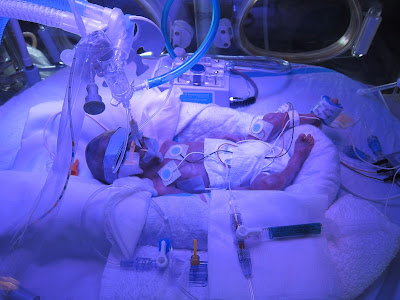Tonight Calder is under
blue photo-therapy lights...he's not really this color. The lights help diminish his bilirubin levels. Bilirubin is basically waste that should only be present at certain levels, so since the body isn't able to get rid of it, the lights do it instead. The band around his head is to keep on his
little sunglasses while he soaks up some rays.
Calder was
diagnosed with a patent ductus arteriorosis (PDA),
which is fairly common in preemies. In short, it’s a blood vessel that’s open
in the womb that should close after birth, but hasn't yet. When open, it allows oxygen-rich blood to mix
with and be diluted by oxygen-poor blood. Tiffany, one of our NICU nurses,
suspected the condition based on his vitals and the doctors confirmed the
diagnosis by listening for a murmur and checking it out on an echocardiogram.
The first treatment option they’ll pursue is medication, one dose of indomethacin
for three days; if the hole does not close, they can give round two over the
course of the next three days. If the medicine doesn't lead to improvement the
second time, they’ll opt for surgery. (There is another medical procedure available to treat it, but only in bigger kids.)
The nurses
say the hole almost always closes with the meds, though the doctors did not
(and don’t usually) express the same optimism.
They are
giving him 1 cc of breast milk every several hours to test how well his gut can
digest it. This is called a "trophic feed."
His first head
scan came back normal. But because this one was done so soon after birth, and bleeds
tend to occur in the first several days of life, they’ll do another scan next
Tuesday. Bleeds become much rarer after 30 days.

No comments:
Post a Comment